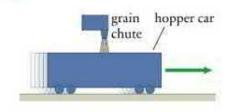An uncoupled (20,000-mathrm{kg}) railroad hopper car coasts along a track at (2.0 mathrm{~m} / mathrm{s}). As it
Question:
An uncoupled \(20,000-\mathrm{kg}\) railroad hopper car coasts along a track at \(2.0 \mathrm{~m} / \mathrm{s}\). As it passes a grain chute, the chute opens (Figure P6.81), grain fills the car at a rate of \(4000 \mathrm{~kg} / \mathrm{s}\) for \(5.0 \mathrm{~s}\), and the chute closes.
(a) How fast is the car going after the chute closes?
(b) How far does the car travel during the \(5.0 \mathrm{~s}\) in which grain is being added? (This distance is the length of the trail of grain in the car.)
(c) Where is the center of mass of the grain-car system at the end of the \(5.0 \mathrm{~s}\) ?
(d) Where is the center of mass of the trail of grain at the end of the \(5.0 \mathrm{~s}\) ?
(e) Why doesn't the center of mass of the trail of grain coincide with the point midway between the two ends of the trail?
Data from Figure P6.81

Step by Step Answer:






